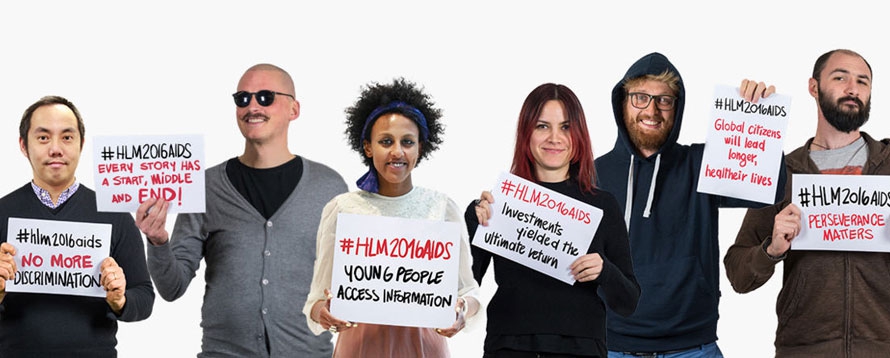エイズ&ソサエティ研究会議のHATプロジェクトのブログに載せた国連合同エイズ計画(UNAIDS)のプレスリリース『エイズ終結に向けた2016年国連総会ハイレベル会合へのカウントダウン』の日本語仮訳を再掲します。
http://asajp.at.webry.info/201603/article_1.html
UNAIDSのカウントダウンページはこちら
http://www.hlm2016aids.unaids.org/index.php/ending-aids-means/

(解説) 国連合同エイズ計画(UNAIDS)の公式サイトに3月2日から、エイズ終結に向けた2016年国連総会ハイレベル会合へのカウントダウンのページが開設されました(注)。そのプレスリリースの日本語仮訳です。
予定されている会議に向けたカウントダウンというのは、とってつけたような印象が否めず、私などは個人的にどうもしっくりこない印象もあります。でも、そういうことを言っていたのでは政治家や国際公務員は務まらないのでしょうし、新聞記者としても大成は期待できないのでしょうね、きっと(実際、大成しなかったけれど)。
そんな違和感も多少は抱きつつ、それでもまあ、なぜ、いま、世界がHIV/エイズ対策に取り組むのかということを考える上ではいい機会かもしれないと思い直して、拙い翻訳作業を進めました。世界の趨勢を見渡せば、重要な課題であっても、おとなしくしていたら心おきなく無視されかねない。そんな現状もあり、手数は多ければ多いほどいいという考え方もまた、成り立つと考えるべきなのでしょうね。グチに等しい前置きはさておき、以下日本語仮訳をご覧下さい。
(注:計算してみると3月2日から100日はだと6月9日になります。6月8日の開幕にあわせると3月1日になるはずなのですが、最近は計算のあやふやさにますます自信を深めているので、間違っているかもしれません。誤りがあればご指摘ください)
◇
エイズ終結に向けた2016年国連総会ハイレベル会合へのカウントダウン
【2016年3月2日 ジュネーブ】 エイズ終結に向けた2016年国連総会ハイレベル会合が米国ニューヨークで開幕するまであと100日となった。会合は6月8日から10日まで開かれ、持続可能な開発目標の一部である2030年のエイズ流行終結を軌道に乗せるには、今後5年間がいかに重要であるかに焦点が当てられる。
この会合は国連総会のモーエンス・リュッケトフト議長が招集し、スイス国連代表部、ヨルグ・ラウバー大使とザンビア国連代表部、パトリシア・ムワバ・カセセ-ボタ大使が共同進行役を務める。
「エイズの流行への対応はいまが正念場です」とリュッケトフト議長は語る。「高速対応に必要な条件を整え、2030年にエイズの流行を終結に導くことを可能にするには、すべての加盟国が協力し、力強い政治宣言をまとめなければならない」
国連合同エイズ計画(UNAIDS)の高速対応アプローチは、締切りを設定した一連のターゲットを打ち出している。2014年に200万人だった年間の新規HIV感染者数を2020年には50万人に減らすこと、2014年に年間120万人だったエイズ関連の死者数も2020年には50万人に減らすこと、そしてHIV関連の差別をなくすことなどだ。
「今後5年でエイズの流行終結を軌道に乗せられるチャンスはそう大きいわけではありません」とUNAIDSのミシェル・シディベ事務局長は言う。「この会合はこれまでの勢いをさらに加速させ、世界が流行を止めるための動きを継続させるうえで極めて重要な意味があります」
世界はいままさにHIVへの投資拡大を必要としている。そうしなければ過去15年間の成果も台無しになり、流行は再び拡大するおそれがある。2015年には推計217億ドルが低・中所得国のエイズ対策に投入された。高速対応を実現するには今後も投資を年々、増やし2020年のピーク時には現在より40%拡大する必要がある。最も大きな資金を必要としている地域や集団に焦点を当てて投資の再配置をはかることで、HIVの流行の影響を最も受けている人たちの生命を予防と治療の対策で救うことができる。高速対応目標を予定通り達成することができれば、2021年以降の資金需要は減少していくことになるだろう。こうした投資の前倒しがなければ、エイズの流行は無限に延びていく恐れがあるのだ。
2011年の国連総会エイズ・ハイレベル会合では、世界の指導者が2015年までに1500万人に抗レトロウイルス治療を提供するという野心的な目標を掲げた。国連の潘基文事務総長は昨年、この目標が達成され、それを上回る成果をあげていることを発表した。抗レトロウイルス治療を受けている人の数は2011年当時の2倍に増えているのだ。
6月の会合に向けてHIV陽性者やHIVの流行に影響を受けている人たち、市民社会、民間企業、各国政府、地域機関がこれからの一連の会合やイベントに参加し、HIVへの対応が優先課題であることを再確認していかなければならない。
エイズ終結に向けた2016年国連総会ハイレベル会合まで100日のカウントダウンとして、UNAIDSの公式サイトではこれから毎日、エイズ流行の終結とは何かという世界中のパートナーからのメッセージお届けします。
Countdown to the 2016 United Nations General Assembly High-Level Meeting on Ending AIDS
GENEVA, 2 March 2016—In just under 100 days’ time the 2016 United Nations General Assembly High-Level Meeting on Ending AIDS will take place in New York, United States of America. The meeting, being held from 8 to 10 June, will focus attention on the importance of accelerating the response to HIV over the next five years to set the world on course to end the AIDS epidemic by 2030 as part of the Sustainable Development Goals.
The meeting will be convened by the President of the United Nations General Assembly, Mogens Lykketoft, and co-facilitated by Jürg Lauber, Permanent Representative of Switzerland to the United Nations, and Patricia Mwaba Kasese-Bota, Permanent Representative of Zambia to the United Nations.
“We are at a critical moment in the response to the AIDS epidemic,” said Mr Lykketoft. “All Member States must work together on a strong political declaration that will create the conditions needed to Fast-Track action and end the AIDS epidemic by 2030.”
The UNAIDS Fast-Track approach has a set of time-bound targets, including reducing the number of people newly infected with HIV from 2 million in 2014 to fewer than 500 000 in 2020, reducing the number of people dying from AIDS-related causes from 1.2 million in 2014 to fewer than 500 000 in 2020 and eliminating HIV-related discrimination.
“Over the next five years we have a fragile window of opportunity to shift gear and put the global HIV response firmly on the Fast-Track to end the AIDS epidemic,” said UNAIDS Executive Director Michel Sidibé. “This meeting will be critical to harnessing the momentum we have built and securing global commitment to break the epidemic for good.”
The world urgently needs to increase HIV investments now or risk reversing the major successes achieved in the first 15 years of the millennium. In 2015, an estimated US$ 21.7 billion was invested in the AIDS response in low- and middle-income countries. Investments need to increase, year on year from 2015, up to a peak of 40% higher in 2020, to reach the Fast-Track Targets. Adopting the Fast-Track focus on location and population and reallocating resources to where they are most needed will ensure that people most affected by HIV are reached with life-changing HIV prevention and treatment services. Achieving all the Fast-Track Targets on time would ensure that estimated total resource needs begin to fall by 2021. Without these front-loaded investments the world risks prolonging the epidemic indefinitely.
At the last United Nations General Assembly High-Level Meeting on AIDS, held in 2011, world leaders set an ambitious treatment target of 15 million people accessing antiretroviral therapy by the end of 2015. The United Nations Secretary-General, Ban Ki-moon, announced last year that this had been achieved and surpassed, with nearly 16 million people accessing antiretroviral therapy by mid-2015—double the number in 2011.
In the lead-up to the meeting in June, people living with and affected by HIV, civil society, the private sector, governments and regional bodies will come together at a series of meetings and events to reaffirm the priorities of the response to HIV.
The 100-day countdown to the United Nations General Assembly High-Level Meeting on Ending AIDS will be reflected on the UNAIDS website with daily messages from partners around the world on what ending AIDS means to them.